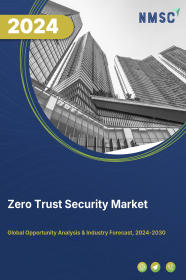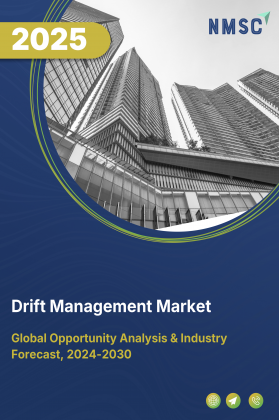
Zero Trust Security Market by Component (Solution and Services), by Deployment Model (On-premise and Cloud), by Enterprise Size (Large Enterprises and SMEs), by Authentication (Single-factor Authentication, and Multi-factor Authentication), by Industry Vertical (BFSI, Government, IT & Telecom, Manufacturing, Healthcare, Retail, Energy & Utilities, and Others) - Global Opportunity Analysis and Industry Forecast 2023-2030
Market Definition
The global Zero Trust Security Market size was valued at USD 26.70 billion in 2022 and is predicted to reach USD 94.77 billion by 2030 with a CAGR of 17.1% from 2023-2030.
Zero trust security refers to a cybersecurity model that assumes all users, systems, and networks are untrusted and all connections must be authenticated and authorized in order to access any resource. It adopts a proactive approach to security by continuously verifying and validating the identity and security posture of users, devices, and applications before granting access to resources. Zero trust security focuses on strict access controls, multi-factor authentication, continuous monitoring, and real-time risk assessment to ensure secure access and protect against potential threats and unauthorized activities.
Market Dynamics and Trends
The demand for the zero-trust security is significantly boosted due to the rising number of cyber-attacks such as phishing and data theft, and others in various industries including healthcare, financial institutions and others. According to a report published by the Federal Bureau of Investigation (FBI), damages caused by ransomware in the US, amounted USD 29.1 million in 2020.
Also, the growing prevalence of IT and telecommunication industry globally is significantly propelling the demand for zero trust security market. This industry plays a critical role in the global economy, relying heavily on digital technologies and communication networks. As organizations in this sector expand their operations, they face a higher risk of cyber threats and attacks. To mitigate these risks, they are adopting zero trust security solutions. Zero trust security ensures strict access controls, continuous authentication, and real-time risk assessment, protecting networks, systems, and sensitive data from unauthorized access.
In addition, the growing adoption of cloud technologies in business organizations to increase data security and improve efficiency is further boosting the global market. Moreover, the constant development of internet connectivity and major technological improvements such as 5G, blockchain, cloud services, internet of things, and artificial intelligence is accelerating the zero trust security Market growth.
However, the high execution cost of the zero-trust security restrains the market growth as small and medium-sized businesses find it difficult to implement a zero-trust security model due to limited capital funding.
On the other hand, the introduction of Web 4.0, characterized by advanced technologies such as artificial intelligence (AI), internet of things (IoT), and cloud computing, is expected to create significant opportunities for the zero-trust security market. Web 4.0 brings increased interconnectedness and complexity, resulting in higher cyber risks. Zero trust security offers strong protection against evolving threats by focusing on continuous authentication, strict access controls, and real-time risk assessment in the Web 4.0 era.
Market Segmentation and Scope of Study
The zero-trust security market report is segmented on the basis of component, deployment model, enterprise size, authentication, industry vertical, and geography. Based on components, the market is classified into solutions and services. Based on the deployment model, the market is segmented into on-premise, and cloud. On the basis of enterprise size, the market is categorized into large enterprises and SMEs. On the basis of authentication, the market is divided into single-factor authentication and multi-factor authentication. Based on industry vertical, the market is divided into BFSI, government, IT and telecom, manufacturing, healthcare, retail, energy & utilities, and Others. Geographical breakdown and analysis of each of the aforesaid classifications include regions comprising of North America, Europe, Asia-Pacific, and RoW.
Geographical Analysis
North America dominates the global zero trust security market share and is potently expected to remain dominant in the market throughout the forecast period. This is attributed to the initiatives and huge investments by the government for adopting cybersecurity solutions are further accelerating the zero-trust security market growth.
For instance, in March 2022, the government of the United States approved USD 10.9 Billion for cybersecurity, allocating around USD 2.6 billion to the Department of Homeland Security’s (DHS) Cybersecurity and Infrastructure Security Agency (CISA). Such investments by the government for strengthening cybersecurity at various platforms which pave the way for the global market.
Also, several initiatives including product launches and collaborations by the major market players such as Google Inc, IBM Corporation, and Palo Alto Networks Inc is further fueling the growth of the zero-trust security market in the region. For instance, in May 2022, Palo Alto Networks expanded their collaboration with Deloitte to offer managed security services to their shared US clients. The new alliance would include threat detection, 5G security, and Zero Trust Enterprise for US firms.
On the other hand, Asia Pacific shows substantial growth in the global market owing to the rising usage of IoT and AI-based devices in developing economies such as China, India, and Japan.
Also, the increase in the number of digital payments in the region is accelerating the growth of the market as the platform used for digital payments requires data security. According to Global Findex Database 2021 by World Bank, in developing economies such as China and India, about 40 percent of adults made payments through digital platforms. About 80 percent of adults made a digital merchant payment in China, whereas in other developing economies 20 percent of adults did so.
Competitive Landscape
The zero-trust security industry includes several market players such as Akamai Technologies Inc., Trellix, Broadcom Inc., Centrify Corporation, Cisco Systems Inc., Google Inc., IBM Corporation, Microsoft Corporation, Palo Alto Networks Inc. and Sophos Ltd. These market players are adopting various strategies such as launches and collaboration to maintain their dominance in the global market.
For instance, in May 2022, Akamai Technologies entered into a partnership with Fujitsu to help the companies in Australia to defend against the data threat of ransomware and cybersecurity attacks affecting critical infrastructure and digital assets.
Moreover, in April 2022, Cisco collaborated with Telenor Group to automate Telenor’s internal security operations to enhance automation & performance as well as provide in-depth visibility, threat intelligence and protection.
Key Benefits
-
The report provides quantitative analysis and estimations of the zero-trust security market from 2023 to 2030, which assists in identifying the prevailing market opportunities.
-
The study comprises a deep-dive analysis of the zero-trust security market including the current and future trends to depict prevalent investment pockets in the market.
-
Information related to key drivers, restraints, and opportunities and their impact on the market is provided in the report.
-
Competitive analysis of the players, along with their market share is provided in the report.
-
SWOT analysis and Porters Five Forces model is elaborated in the study.
-
Value chain analysis in the market study provides a clear picture of roles of stakeholders.
Zero Trust Security Market Key Segments
By Component
-
Solution
-
Services
By Deployment Model
-
On-premise
-
Cloud
By Enterprise Size
-
Large Enterprises
-
SMEs
By Authentication
-
Single-factor Authentication
-
Multi-factor Authentication
By Industry Vertical
-
BFSI
-
Government
-
IT and Telecom
-
Manufacturing
-
Healthcare
-
Retail
-
Energy and Utilities
-
Others
By Region
-
North America
-
U.S
-
Canada
-
Mexico
-
-
Europe
-
Germany
-
France
-
Italy
-
Spain
-
United Kingdom
-
Russia
-
Sweden
-
Rest of Europe
-
-
Asia-Pacific
-
Australia
-
China
-
India
-
Japan
-
South Korea
-
Indonesia
-
Singapore
-
Rest of Asia-Pacific
-
-
RoW
-
Latin America
-
Middle East
-
Africa
-
KEY PLAYERS
-
Akamai Technologies Inc.
-
Trellix
-
Broadcom Inc.
-
Centrify Corporation
-
Cisco Systems Inc.
-
Google Inc.
-
IBM Corporation
-
Microsoft Corporation
-
Palo Alto Networks Inc.
-
Sophos Ltd.




















 Speak to Our Analyst
Speak to Our Analyst

























